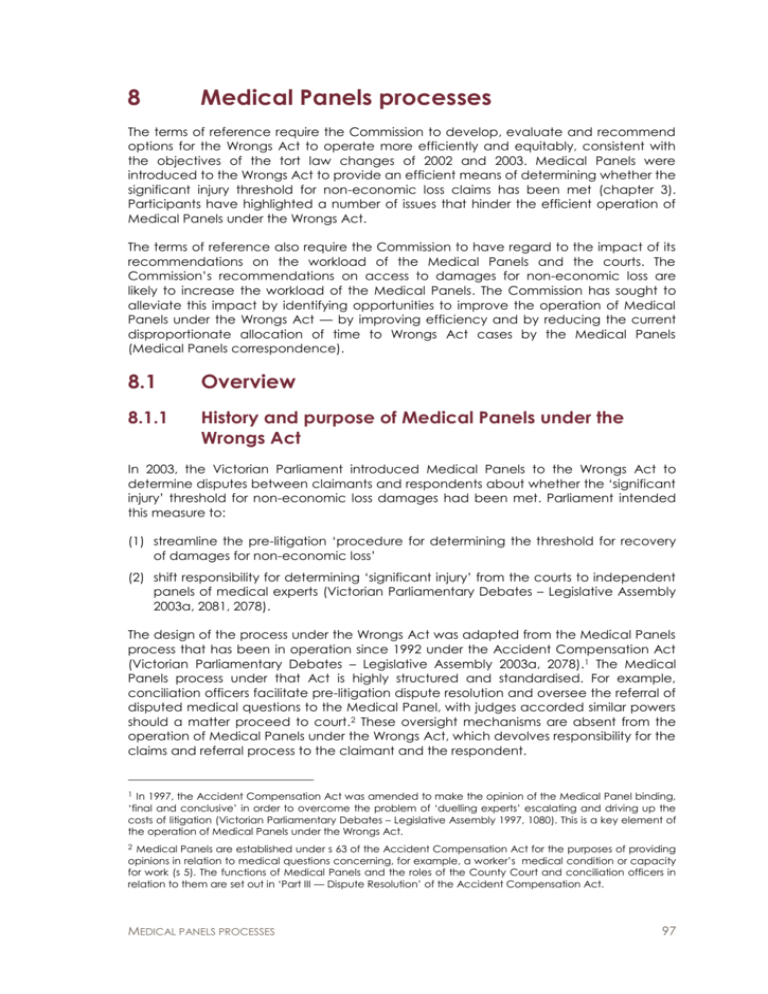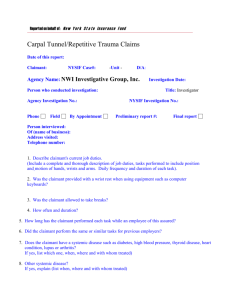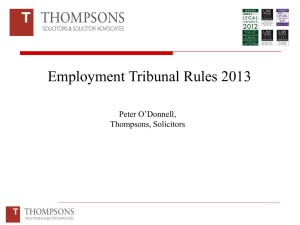Chapter 8 - Medical Panels processes
advertisement

8 Medical Panels processes The terms of reference require the Commission to develop, evaluate and recommend options for the Wrongs Act to operate more efficiently and equitably, consistent with the objectives of the tort law changes of 2002 and 2003. Medical Panels were introduced to the Wrongs Act to provide an efficient means of determining whether the significant injury threshold for non-economic loss claims has been met (chapter 3). Participants have highlighted a number of issues that hinder the efficient operation of Medical Panels under the Wrongs Act. The terms of reference also require the Commission to have regard to the impact of its recommendations on the workload of the Medical Panels and the courts. The Commission’s recommendations on access to damages for non-economic loss are likely to increase the workload of the Medical Panels. The Commission has sought to alleviate this impact by identifying opportunities to improve the operation of Medical Panels under the Wrongs Act — by improving efficiency and by reducing the current disproportionate allocation of time to Wrongs Act cases by the Medical Panels (Medical Panels correspondence). 8.1 Overview 8.1.1 History and purpose of Medical Panels under the Wrongs Act In 2003, the Victorian Parliament introduced Medical Panels to the Wrongs Act to determine disputes between claimants and respondents about whether the ‘significant injury’ threshold for non-economic loss damages had been met. Parliament intended this measure to: (1) streamline the pre-litigation ‘procedure for determining the threshold for recovery of damages for non-economic loss’ (2) shift responsibility for determining ‘significant injury’ from the courts to independent panels of medical experts (Victorian Parliamentary Debates – Legislative Assembly 2003a, 2081, 2078). The design of the process under the Wrongs Act was adapted from the Medical Panels process that has been in operation since 1992 under the Accident Compensation Act (Victorian Parliamentary Debates – Legislative Assembly 2003a, 2078).1 The Medical Panels process under that Act is highly structured and standardised. For example, conciliation officers facilitate pre-litigation dispute resolution and oversee the referral of disputed medical questions to the Medical Panel, with judges accorded similar powers should a matter proceed to court.2 These oversight mechanisms are absent from the operation of Medical Panels under the Wrongs Act, which devolves responsibility for the claims and referral process to the claimant and the respondent. 1 In 1997, the Accident Compensation Act was amended to make the opinion of the Medical Panel binding, ‘final and conclusive’ in order to overcome the problem of ‘duelling experts’ escalating and driving up the costs of litigation (Victorian Parliamentary Debates – Legislative Assembly 1997, 1080). This is a key element of the operation of Medical Panels under the Wrongs Act. 2 Medical Panels are established under s 63 of the Accident Compensation Act for the purposes of providing opinions in relation to medical questions concerning, for example, a worker’s medical condition or capacity for work (s 5). The functions of Medical Panels and the roles of the County Court and conciliation officers in relation to them are set out in ‘Part III — Dispute Resolution’ of the Accident Compensation Act. MEDICAL PANELS PROCESSES 97 8.1.2 Overview of the Medical Panels process Typically, a Medical Panel is only involved in a claim for non-economic loss damages when a respondent disputes a claim following service of a Certificate of Assessment (Certificate), in which a medical doctor certifies that the degree of impairment suffered by the claimant meets the significant injury threshold (chapter 3). Figure 8.1 depicts the process described below. The role of the claimant The claimant initiates the claims process by obtaining an assessment of physical and/or psychiatric impairment from an approved medical practitioner (chapter 3). 3 If the requisite degree of impairment is certified, the claimant may then choose to serve the Certificate on the respondent (s 28LT).4 This must be accompanied by ‘prescribed information’, which includes, among other things, personal details and descriptions of the incident and the injury, including its impact on the claimant (s 28LT(2)). 5 To assist claimants and their legal representatives, the Department of Justice provides some general guidelines and templates on its website (DOJ 2013). The role of the respondent When served with a Certificate and the prescribed information, the respondent has 60 days to reply in one of four ways: accept the claim request further information dispute whether he or she is the correct respondent dispute the claimed degree of impairment by referring a ‘medical question’ to the Medical Panel (s 28LW). Failure to respond in writing within 60 days results in a deemed acceptance of the claim (s 28LW(4)). If the respondent disputes the Certificate supporting the claim, he or she is required to refer a medical question to the Medical Panel, which favours the following wording: ‘Does the degree of impairment resulting from the injury to the claimant alleged in the claim satisfy the threshold level?’ (Medical Panels 2008, 4). 3 The claimant may also seek the respondent’s agreement to waive the requirement for a medical assessment (s 28LO(1)). 4 The Wrongs Act also provides for Certificates to be issued when the injury has not stabilised, provided that, among other things, the medical practitioner is satisfied that the degree of impairment will satisfy the threshold once the injury has stabilised (s 28LNA). 5 Regulation 6 of the Wrongs (Part VBA Claims) Regulations 2005 prescribes, among other things, the following information: details of the incident and resulting injury; details of any resulting pain and suffering, loss of amenities or enjoyment of life; details of any report of the incident on which the claimant intends to rely; details of any medical practitioner who has treated the injury of the claimant. 98 ADJUSTING THE BALANCE: INQUIRY INTO ASPECTS OF THE WRONGS ACT 1958 Stylised representation of the Medical Panels process Claimant serves Certificate of Assessment and prescribed information on respondent. Respondent decides whether to: (a) Accept the claim (b) Request further information (c) Dispute whether they are the correct respondent (d) Refer ‘medical question’ to Medical Panel. Respondent has 60 days in which to respond to the claimant. Respondent can request more information from the claimant within the 60 days. Where (d) occurs, the respondent provides the prescribed information, a copy of Certificate of Assessment and the medical question to the Medical Panel. The Medical Panel favours a generic wording of the medical question, as follows: ‘Does the degree of impairment resulting from the injury to the claimant alleged in the claim satisfy the threshold level?’. The Convenor of Medical Panels decides whether to convene a Panel based on information provided in the referral, including the medical question. The Convenor may request: The respondent to amend medical question to comply with s 28LB Further documentation from the respondent or claimant (for example, medical records). If a Medical Panel is convened, it considers relevant medical information, including the claimant’s medical history, to determine the degree of impairment. The Medical Panel must disregard unrelated injuries or causes. The Medical Panel may ask the claimant to supply all documents in their possession that relate to the medical question, to meet and answer questions, and to submit to a medical examination. The Medical Panel makes a determination on whether the injury meets the ‘significant injury’ test. Source: Commission analysis. MEDICAL PANELS PROCESSES 99 The respondent must also provide the Medical Panel with the Certificate and with prescribed information, which, like that provided by the claimant, includes personal details and descriptions of the incident and the injury (s 28LZA(1), Wrongs (Part VBA Claims) Regulations 2005 r 7). The Commission understands that respondents may use this as an opportunity to contest the claimed impairment, and to submit any material that they consider relevant to the medical question (Medical Panels correspondence). To assist respondents to make an effective referral, the Medical Panel publishes guidance material and templates on its website (also available on the Department of Justice website) (Medical Panels 2013; DOJ 2013). Finally, respondents are responsible for the costs which follow the referral of a medical question (s 28LX). The role of Medical Panels Part VBA of the Wrongs Act sets out the procedures that a Medical Panel must follow to determine whether a claimant meets the significant injury threshold. 6 In keeping with Parliament’s intention for a streamlined, non-judicial pre-litigation process, Medical Panels are required to ‘act informally, without regard to technicalities or legal forms and as speedily as a proper consideration of the reference allows’ (s 28LZ(2)). Upon receiving a referral, the Convenor of Medical Panels Victoria decides whether to convene a Medical Panel, based on information contained in the referral. The Convenor may request the respondent to amend the medical question to comply with s 28LB, and may request further documentation from the respondent and/or the claimant (for example, medical records). Once convened, a Medical Panel determines whether the claimant's degree of impairment satisfies (or will satisfy when the injury has stabilised) the threshold level, but must not state the specific degree of impairment (s 28LZG). In doing so, all unrelated injuries or causes must be disregarded. This determination must be accepted by a court in any proceeding in relation to the claim (s 28LZH).7 The Medical Panel’s decision therefore functions as a gateway to one of two outcomes, depending on whether the significant injury threshold is met: (1) If not met, a claimant’s entitlement to non-economic loss damages is terminated. (2) If met, the claimant’s entitlement is partially established, with the ultimate outcome depending on settlement or the resolution at trial of various other issues, such as negligence and causation. Number of Wrongs Act referrals From 2010-11 to 2012-13, the Medical Panels received 1377 Wrongs Act referrals. Of these referrals, 731 or around 55 per cent were categorised as ‘slips/trips and falls’, while 315 or around 25 per cent were medical-related claims for ‘failed or injurious treatment by practitioner or consultant’ (table 8.1). 6 Section s 28LZL also incorporates relevant provisions of the Accident Compensation Act 1985 (Vic). 7 No appeal on the merits may be made to a court from an assessment or determination of a Medical Panel (s 28LZI(1)). The only right of appeal is by way of judicial or administrative law review (Pillay 2010, 4–12). 100 ADJUSTING THE BALANCE: INQUIRY INTO ASPECTS OF THE WRONGS ACT 1958 Wrongs Act referrals by type of event: 2010-11 to 2012-13 Type of event Number Percentage of all events (%) Slips/trips and falls 731 56 Failed or injurious treatment by practitioner or consultant 315 24 Impact by object 56 4 Care/custody/control 55 4 Traumatic event, witness or exposed to 39 3 Physical assault 27 2 Sport/recreation 19 1 Faulty product 15 1 Fire 14 1 Fall from height 11 1 Collapse of building/structure 10 1 Discrimination/harassment 10 1 Notes: A number of other categories had less than 10 referrals: abuse/molestation; accidental breakage; animal bite/attack; dog bite/attack; electric shock; environmental contamination or pollution; equipment breakdown; explosion and/or vibration; exposure to or contact with substance; faulty workmanship; impact by animal; impact or damage by vehicle; lifting; carrying or putting down objects; long term exposure to sound or noise; machinery use; negligent advice; other causes; other contamination; repetitive/overuse injury; subsidence/landslide; water. The following categories had zero referrals: asbestos; defamation/slander; excavation/drilling damage; exposure to sudden sound or noise; lease liabilities; mould; other financial loss; rusting/oxidation/discolouring; spray drift; trapped by machinery or equipment; weakening and/or removal of supports; welding; worker to worker injury. Source: Medical Panels correspondence. 8.2 Key issues In submissions and discussions with the Commission, participants raised issues concerning, in particular: (1) the commencement of the claim by the claimant (2) the referral of the medical question by the respondent. Participants also raised other issues in relation to multiple respondents and the cost of general damages claims. 8.2.1 Commencement of the claim by the claimant Participants raised two sets of issues concerning the commencement of the claim by the claimant, relating firstly to the prescribed information that the claimant must serve on the respondent and secondly to the timing of service. MEDICAL PANELS PROCESSES 101 Prescribed information The Commission identified four issues concerning the provision of prescribed information by the claimant to the respondent: (1) The prescribed information may be incomplete. According to Norton Rose Fulbright (NRF), it is ‘not uncommon for claimants to serve Certificates without’ prescribed information, such as medical information or the details of treating medical practitioners (sub. 8, 3). Wotton + Kearney (WK) supported this submission (sub. 18, 2). NRF submitted that this ‘hamper[s] a respondent’s ability to gauge whether or not a medical question should be referred to the Medical Panel’ (sub. 8, 3). It also increases the workload of the Medical Panel, which must then make further requests of the claimant for missing information (trans. 2, 1). For NRF, the provision of incomplete information ‘undermines the efficiency of the Medical Panel referral process’ (sub. 8, 4). (2) The prescribed information may arrive in a piecemeal fashion, which delays the progress of the claim and hampers the respondent’s ability to decide whether to refer (trans. 2, 2). It can also lead to disputes between claimants and respondents about whether the prescribed information has been provided (trans. 2, 2).8 (3) According to WK, the prescribed information is not accompanied by a warning to the respondent about the 60 day time limit for responding to a claim (sub. 18, 4). This ‘has caused significant prejudice to some respondents’, particularly where the respondent has no prior litigation experience, or where the claims department of an insurance company is located interstate and is not entirely familiar with the requirements of the Wrongs Act (sub. 18, 4; trans. 2, 2). WK submitted that they have experienced ‘many occasions’ where respondents’ lack of awareness of this time limit has led to a failure to refer the claim to their insurer within the 60 days. In some cases, this has ‘compromised the respondent’s right to indemnity because late notice of the claim has prejudiced the insurer’s rights’ (sub. 18, 4). (4) The Municipal Association of Victoria (MAV) submitted that ‘the current process does not ensure that the Medical Panel has all the relevant material before it to assist in its decision-making’ because the claimant is not required to provide ‘material regarding relevant pre-existing conditions or prior injuries’ (sub. 12, 14). The Commission’s view The Commission’s view is that issues ‘1’ and ‘2’ could be addressed by requiring the claimant to serve the prescribed information in a prescribed form. The Law Institute of Victoria (LIV) supported this approach, adding that it should incorporate the ‘prescribed information set out at s 28LT(3) and Regulation 6’ (sub. DR24, 14). Presently, the claimant is not required to provide the prescribed information in a single document, such as a pro forma. This permits information to be provided in a piecemeal fashion, as it allows for information about the injury and incident to be provided by way of, for instance, a statement of claim or a letter of demand, alongside other prescribed information included in other documents (trans. 2, 1). In the Commission’s view, requiring the claimant to provide the prescribed information in a prescribed form, completion of which is a statutory prerequisite for effective service by the claimant, would address issues ‘1’ and ‘2’. Issue ‘3’ could be addressed by 8 WK supported this point, submitting that the absence of clear guidelines regarding prescribed information can lead to costly and time-consuming litigation, citing as an example the case of Redline Towing & Salvage Pty Ltd & v The Convenor of Medical Panels [2012] VSC 472 (sub. 18, 5). 102 ADJUSTING THE BALANCE: INQUIRY INTO ASPECTS OF THE WRONGS ACT 1958 including a front-page warning on the prescribed form to respondents on the time limits for replying. Ideally, the prescribed form needs to be available to fill out electronically on the Medical Panels Victoria website, and should be accompanied by a step-by-step guide to assist claimants to complete it correctly. Regarding options for addressing issue ‘4’, some participants expressed concern about combining a prescribed form requirement with a further requirement for claimants to provide respondents with exhaustive materials, such as medical reports and records (trans. 2, 2). The LIV submitted that this ‘would result in an onerous and unnecessary front-loading of claims in terms of both costs and delay’ (sub. DR24, 14). By contrast, Avant submitted that the referral process could be expedited by requiring the claimant to supply the respondent with a ‘schedule listing all health information that the claimant has in his or her possession power or control’, which would then allow the respondent to obtain the information it considered relevant (sub. DR19, 4-5). On balance, the Commission considers that the introduction of a prescribed form will improve the efficiency of the claims and referral process, and that further changes risk increased costs and delay, particularly if claimants are required to provide exhaustive materials. Timing and interaction of Medical Panels with the courts Several participants noted that the Wrongs Act does not require the claimant to serve the respondent with the Certificate and prescribed information within a specified time. WK submitted that ‘the Certificate can be served at any stage of the [Court] Proceeding’, with NRF adding that ‘it is not uncommon for a claimant to provide a respondent with a Certificate after a period of unacceptable delay or at an opportunistic juncture in a litigated proceeding’ (sub. 18, 2; sub. 8, 3). Avant proposed ‘that a certificate should be required to be served before or at the time of serving the statement of claim, so as to give certainty to the defendants as to what head of damage the plaintiff will pursue’ (sub. 16, 3). To illustrate their submission, WK cited the County Court matter of Pickering v Killians Walk Owners Corporation [2013] VCC 1206 (‘Pickering v Killians’), in which they acted for the respondent. The claimant sought to fix a trial date for her claim for damages, without declaring whether she intended to claim both non-economic loss and economic loss (Pickering v Killians, [6]). The respondent sought a stay of proceedings so that the claimant’s potential entitlement to non-economic loss damages could be determined, thus avoiding preparation of a potentially unnecessary defence [6-7]. The claimant indicated that she may not presently be able to satisfy the significant injury threshold for her non-economic loss claim. She indicated that she would ‘not make the decision whether to abandon a claim for non-economic loss until … the date for trial is impending (Pickering v Killians, [8]). In his written judgment, Judge Misso noted that there was no power under the Wrongs Act for him to stay the proceedings, which he described as ‘a very unsatisfactory position which I think was an unintended consequence of Part VBA’ and emphasised the importance of both parties creating ‘certainty so that the real issues to be tried come to the surface as soon as that is practicable’ (sub 18, 3; Pickering v Killians, [13, 17]). The consequence of this, according to WK, can be ‘considerable uncertainty for a respondent’ which can prejudice the preparation of the case and can hinder the prospects of settlement between parties (sub. 8, 3). The LIV commented that any response to this issue should not require the claimant to serve the Certificate before proceedings commence: in some cases, particularly those MEDICAL PANELS PROCESSES 103 involving medical negligence, this could delay commencement beyond the expiry of the three-year limitations period, an eventuality which would prejudice the claimant’s right to seek compensation (sub. DR24, 14). The Commission’s view The absence of a timing requirement becomes an issue when litigation progresses to the point where a trial date must be set. If a claimant continues to indicate an intention to claim for non-economic loss at this point, but does not serve the respondent with a Certificate, the respondent is required to prepare a potentially unnecessary defence, which is costly and time-consuming. The Commission understands that in related personal injury matters, the court has an inherent jurisdiction9 to order a plaintiff in a personal injuries case to submit to a medical examination by a medical expert chosen by the defendant (LexisNexis 2013, 325-8250).10 A court may then grant a stay of proceedings if ‘a [claimant] unreasonably fails, refuses or neglects to attend a medical examination as directed by the court’ (Thomson Reuters 2012, 5.3.95).11 Depending on the jurisdiction, courts also have other sanctions available to them, such as dismissing the claim or suspending any entitlement to damages until the plaintiff submits to the medical examination (LexisNexis 2013, 325-8265).12 Some participants submitted that it might be possible for court Practice Notes to be changed so that the trial date would not be set until the Certificate and the prescribed information were served (trans. 2, 3). According to the LIV, ‘the incorporation of an order for service of a certificate of assessment in the usual Court timetable would present little difficulty’ (sub. DR24, 15). However, the Commission notes that Judge Misso was unable to make such an order because his power to do so was limited by the provisions of Part VBA of the Wrongs Act: I cannot order that the plaintiff take the steps set out in Part VBA, because there is no power under the Act for me to make such an order. If I had the power, I would not hesitate to make that order. (Pickering v Killians, [13]) The Commission notes that the terms of reference require it to have regard to the impact of its recommendations on the workload of courts. The Commission therefore considers that an amendment to Part VBA is required in order to grant the court the discretionary authority to manage a relevant Wrongs Act proceeding by: (1) ordering the claimant to serve the respondent with the Certificate and the prescribed information (2) staying the proceedings until service has occurred. 9 In this context, inherent jurisdiction refers to the authority of a superior court to prevent abuse of and to manage its own process, without the assistance of an authorizing statutory provision. 10 Examples include Uniform Civil Procedure Rules 2005 (NSW) rr 23.1, 23.2; Supreme Court (General Civil Procedure) Rules 2006 (Vic) rr 33.02, 33.03, 33.04(1); and, Rules of the Supreme Court 1971 (WA) O 28 r 1. 11 Examples include Supreme Court (General Civil Procedure) Rules 2005 (Vic) r 33.04(2), Rules of the Supreme Court 1971 (WA) O 28 r 1(3), and Supreme Court Civil Rules 2006 (SA) r 154(1). 12 Dismissing the claim is available in the Uniform Civil Procedure Rules 2005 (NSW) r 23.9 and the Rules of the Supreme Court 1971 (WA) O 28 r 1(3). Suspending the claimant’s entitlement is provided for by the Supreme Court Civil Rules 2006 (SA) r 154(2). 104 ADJUSTING THE BALANCE: INQUIRY INTO ASPECTS OF THE WRONGS ACT 1958 This measure would introduce greater certainty to the pre-trial process by encouraging, when appropriate, the timely disclosure of the ‘real issues to be tried’ (Pickering v Killians, [17]). This may deny some claimants the advantage of withholding disclosure of their intention to claim non-economic loss damages. However, in the Commission’s view, this cost is outweighed by the benefits to the dispute resolution process as a whole — namely, reduced delay and increased certainty. The Commission notes that these benefits are also consistent with Parliament’s intention for the Medical Panels process to operate as a streamlined pre-litigation procedure. 8.2.2 Referral of the medical question by the respondent Participants raised three issues concerning the referral of the claim to the Medical Panel by the respondent, relating to passing on the claimant’s prescribed information to the Medical Panel, incomplete information, and the wording of the medical question. Passing on the prescribed information received from the claimant The respondent is not required to provide the Medical Panel with copies of all of the prescribed information provided by the claimant. This means that, in the majority of cases, the Medical Panel incurs an additional administrative burden once the referral has been submitted, because it must contact the claimant and/or respondent to obtain the claimant’s prescribed information (trans. 2, 3; Medical Panels correspondence). This also delays the processing of the claim. Incomplete information provided by respondent Based on discussions with Medical Panels Victoria, the Commission understands that the prescribed information that the respondent is required to provide in the referral is sometimes incomplete. The Panel must then request the missing information, which adds to its administrative burden and to the time taken to make an assessment (Medical Panels correspondence). The medical question According to Medical Panels Victoria, there has been an increased incidence of referrals that ask the Medical Panel to consider the issue of causation when assessing impairment (Medical Panels correspondence). This is problematic because the Medical Panel is not permitted to consider causation as an element of the medical question: s 28LB defines the medical question as ‘a question as to whether the degree of impairment resulting from injury to the claimant alleged in the claim satisfies the threshold level’ of significant injury. This definition was introduced in 2003: … to make it clear that the panel’s assessment is based on the injuries that the claimant has cited in his or her claim, and that issues relating to causation are therefore left to the parties or a court to determine. (Victorian Parliamentary Debates – Legislative Assembly 2003b, 1425) This problem typically arises in medical negligence cases, which are more likely to require complex distinctions between the injury at the basis of the claim and the unrelated injuries or causes for which the claimant originally sought treatment. Section 28LL(3) requires the Medical Panel to disregard such unrelated injuries and causes (trans. 2, 3–4). The wording of the medical question becomes problematic when it asks the Panel to consider issues — like causation — that Part VBA does not permit it to consider. This arises because although s 28LB defines the medical question conceptually, it does not set out the permissible phrasing of the question. MEDICAL PANELS PROCESSES 105 To ensure that it makes a determination in response to a permissibly phrased medical question, the Panel has developed an administrative workaround. The Deputy Convenor’s Directions state that if the medical question: … is phrased in a way that does not come within the meaning of section 28LB of the Act, [the Deputy Convenor] will advise the respondent that the correct medical question should be: ‘Does the degree of impairment resulting from the injury to the claimant alleged in the claim satisfy the threshold level?’ (Medical Panels 2008, 4) This issue adds to the administrative burden on the Medical Panel and delays the assessment of referrals. In addition, from discussions with Medical Panels Victoria, the Commission understands that each year about one to two disputes about the form of the medical question progress to litigation (judicial review). This further adds to the administrative burden on the Medical Panel, and to the legal costs incurred by the Medical Panel and the respondent. The Commission’s view The Commission considers that these three issues can be addressed by standardising the referral process along similar lines to those outlined above for claimants. Like claimants, respondents are not presently required to provide their prescribed information in a prescribed form. In the Commission’s view, a prescribed form should be available to fill out electronically on the Medical Panels Victoria website, and should be accompanied by a step-by-step guide to assist respondents to complete it correctly. A prescribed form with the following features would in the Commission’s view be a lowcost solution to the three issues discussed above: (1) Passing on the prescribed information received from the claimant — including this as a required step in the completion of the prescribed form would relieve the Medical Panel of the need to chase up this information after they receive the referral. The LIV considered this requirement to be necessary (sub. DR24, 14). (2) Incomplete information — obliging respondents to complete the prescribed form, assisted by a step-by-step guide, is likely to minimise the provision of incomplete information and the consequential administrative burden. (3) The medical question — the definition of the medical question in s 28LB, reinforced by the second reading speech quoted above, is unequivocal in denying the Medical Panel the authority to consider causation when making an assessment. The Commission considers that the outcome of the current workaround — that is, a generically phrased medical question — could be achieved with greater efficiency by requiring the respondent to ask the medical question in the generic form when making the referral. To achieve this, the prescribed form could include a section requiring the respondent to tick a box marking the appropriate generic medical question, depending on whether the claimed impairment was physical or psychiatric.13 From discussions with Medical Panels Victoria, the Commission understands that a generic medical question would not prevent respondents from making separate submissions regarding whether or not the alleged injury of the claimant was potentially compensable. Nor would a generic medical question 13 This requirement follows on from the recent judgment of Mitchell v Malios [2013] VSC 480, which requires separate Certificates for physical and for psychiatric impairments. This overruled the case of McAlister v Leitch [2011] VSC 51, which required a Medical Panel to be convened to assess physical and psychiatric impairments, even when the Certificate only alleged a physical impairment. 106 ADJUSTING THE BALANCE: INQUIRY INTO ASPECTS OF THE WRONGS ACT 1958 open the door to the Medical Panel including pre-existing injuries in their assessments: s 28LL(3) requires ‘impairments from unrelated injuries or causes … to be disregarded in making an assessment’. According to the LIV, this restriction of the Medical Panel’s powers ensures that their ‘involvement is properly limited to the threshold question and does not become a de facto hearing of the causation and assessment of damages question’ (sub. DR24, 15). 8.3 Estimate of efficiency improvements Based on consultation with Medical Panels Victoria, the Commission understands that the changes discussed above and consolidated in recommendation 8.1 would reduce their administrative workload. Presently, about 20 per cent of the Panel’s administrative time is spent on Wrongs Act referrals, which currently represent about 13 per cent of total referrals received (Medical Panels correspondence). According to Medical Panels Victoria, the above changes could bring the administrative workload closer to the percentage of referrals received, resulting in potential efficiencies for salaries and oncosts of about $67 000 per year (Medical Panels correspondence; table 8.2). In addition, the requirement for a generically worded medical question would eliminate the need for litigation about the wording of the medical question. The Commission understands that this type of litigation occurs on average one to two times per year, with each dispute involving external legal costs of more than $100 000. A reduction in legal fees would result in efficiencies for the Department of Justice, who are responsible for paying the legal fees in respect of the Convenor’s involvement in the litigation, of about $100 000 per year (Medical Panels correspondence). The Commission understands that many of these efficiencies would be mirrored by costs savings for the legal representatives of claimants and respondents. For example, reducing disputes about medical questions would result in a similar reduction in the costs incurred by respondents in those cases. Similarly, reducing the time spent by the Medical Panel contacting claimants and respondents to correct incomplete claims and referrals will inevitably reduce the time spent by legal representatives responding to these requests. Finally, granting courts the authority to manage their proceedings with respect to service of a Certificate is also likely to lead to a reduction in litigation costs incurred by the parties and the courts in cases such as Pickering v Killians. These reductions should offset the potential increase in the workload of the Medical Panels arising from proposed changes to the thresholds (chapter 3). Medical Panels – potential administrative and legal efficiencies per year Days-per-week saving Full-time equivalent saving Legal Manager 0.75 0.15 Legal Administration Officer 1.00 0.20 Administration Officer 1.50 0.30 Position Total estimated administrative savings Plus total estimated savings of legal costs Total Estimated Savings Note: Source: $67 000 $100 000 $167 000 Values may not equate due to rounding. Medical Panels correspondence. MEDICAL PANELS PROCESSES 107 Recommendation 8.1 To reduce transaction costs and improve equity, the Victorian Government amend Part VBA of the Wrongs Act 1958 (Vic) and the Wrongs (Part VBA Claims) Regulations 2005 (Vic) to: require the claimant to serve the prescribed information in a prescribed form grant courts the discretionary authority to: - order the claimant to serve the respondent with the Certificate of Assessment and the prescribed information in the prescribed form - stay proceedings until service has occurred require the respondent to refer the medical question to the Medical Panel using a prescribed form which: - includes a field for selecting the appropriate, generically worded medical question - must be accompanied by a copy of the prescribed information provided by the claimant. To assist claimants and respondents to comply with the prescribed form requirement, Medical Panels Victoria should provide downloadable form templates and user guides on its website. In the long term, if these changes are successful, the Victorian Government could reduce the time for a respondent to reply to a claim from 60 days to 45 days to ensure quicker access to justice. 8.4 Other issues Participants brought two other issues to the attention of the Commission: (1) Two law firms identified problems in relation to whether a Certificate can bind multiple respondents (NRF, sub. 8; WK, sub. 18). This issue arises when one respondent accepts a claimant’s Certificate and another respondent refers the claim to the Panel: if the Panel determines that the degree of impairment does not satisfy the threshold level, an incongruous situation potentially arises where the claimant can assert an entitlement to general damages against the respondent who accepted the Certificate, but not against the respondent who referred the Certificate (NRF, sub. 8, 4). Participants suggested that any approach to the question of whether a determination of the Medical Panel should bind multiple respondents is likely to be fraught with difficulties (trans. 2, 4; sub. DR24, 15). (2) WK submitted that over the past five years there has been a disproportionately large increase in the costs of general damages claimed by plaintiff lawyers in relation to the amount of general damages sought (sub. 18, 4). The Commission considers these two issues to be outside its terms of reference. 108 ADJUSTING THE BALANCE: INQUIRY INTO ASPECTS OF THE WRONGS ACT 1958







